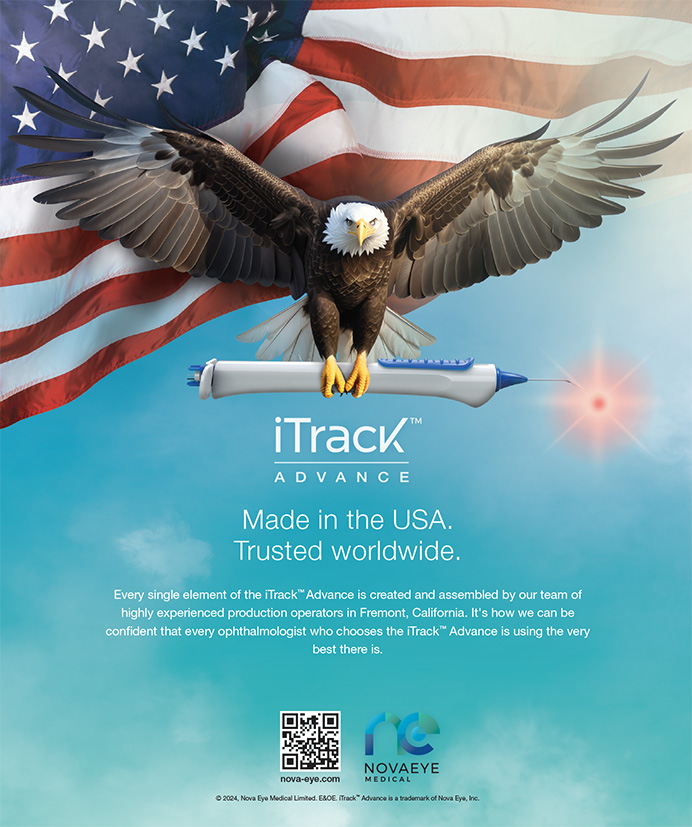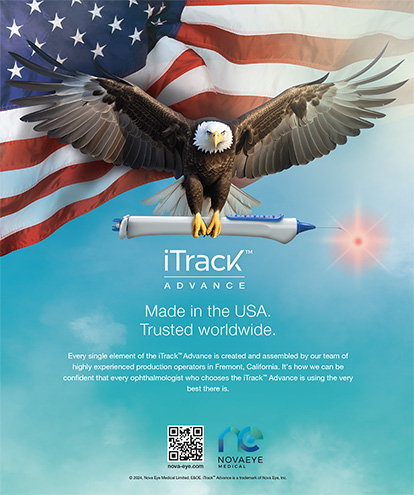By the time I completed my first few cases with the AcrySof Toric IOL (Alcon Laboratories, Inc., Fort Worth, TX), I was convinced that it was the best vision-correction option for cataract patients with moderate-to-severe preoperative corneal astigmatism. This lens gives me the ability to accurately and predictably provide excellent uncorrected distance UCVA for a group of patients who have lived without such vision for years. For an experienced cataract surgeon, the lens is easy to implant and produces excellent outcomes in the very first case. My patients have been effusive about their results. I believe the lens generates a "wow" factor that is unparalleled in cataract surgery.
MY FIRST SERIES OF CONSECUTIVE EYES
In a phase 3 clinical study evaluating the AcrySof Toric IOL, 94 of patients implanted with the lens (n = 37) achieved a distance UCVA of 20/40 or better.1 The study also evaluated the rotational stability of the lens, which of course is crucial to the effectiveness of a toric design. At 6 months after implantation, the mean rotation was less than 4°.
For other key results from the clinical study, see Highlights From the AcrySof Toric IOL Phase 3 Clinical Study. However, I think the results from my first 55 consecutive eyes are even more interesting. They illustrate how quickly quality outcomes can be achieved with this lens.
My series included each of the three models of the lens: the SN60T3, SN60T4, and SN60T5. These lenses are available in powers of 6.00 through 34.00 D in 0.50 D increments. I excluded nine eyes from the data analysis, because they were not expected to achieve 20/40 or better distance UCVA due to planned monovision (an intended myopic result) or known preexisting macular pathology that would preclude normal vision (Table 1).
USING THE INCISION'S PLACEMENT TO FINE-TUNE OUTCOMES
At the time of this writing, I have implanted about 200 AcrySof Toric IOLs with similarly solid results to my first series. One important key to my success with this lens is using the online AcrySof Toric IOL Calculator (www.acrysoftoriccalculator.com) that the manufacturer provides. It is simple to use and accurately predicts outcomes by compensating for surgically induced astigmatism using vector analysis to adjust both the magnitude and axis of astigmatism. The surgeon determines the proper spherical power of the IOL for the operative eye and enters it into the calculator along with the patient's keratometric (K) values, expected induced astigmatism (default, 0.50 D), and location of the incision. With this information, the calculator determines the most appropriate cylindrical power of the lens (ie, the model T3, T4, or T5) and, axis of implantation. In addition, the calculator has recently been enhanced to show the amount and location of the anticipated residual astigmatism following the lens implantation.
In my experience, some residual cylinder with the AcrySof Toric IOL does not usually bother patients. For example, a patient who had 3.00 D of preoperative cylinder tends to be very happy with 0.75 D of cylinder and a UCVA of 20/25 or 20/30 postoperatively. Nevertheless, I take advantage of the fact that the online toric calculator easily allows me to improve upon the suggested outcome by changing the incision's location.
Critical to the overall precision of the AcrySof Toric IOL's calculations is the compensation for surgically induced astigmatism. Few if any incisions are astigmatically neutral. With this lens, moving the axis of the incision closer to the plus power of the cornea reduces the corneal cylinder; moving the axis farther from the plus power has the opposite effect. By using the online calculator to alter the incision's placement, it is possible to achieve the lowest possible amount, if not eliminate residual cylinder.
For example, say a surgeon enter an eye's information into the calculator, including his usual temporal incisional placement. The calculator recommends the SN60T3 and determines a target residual astigmatism of 0.20 D at axis 25°. Surgeons can enter a different location for the incision, closer to axis 25° (the steep axis), in order to reduce the anticipated residual astigmatism. In turn, the calculator will change the recommended placement of the lens.
Alternatively, in an eye with greater preoperative corneal cylinder, a surgeon could use the next more powerful lens model, the SN60T4, and move his incision farther from the natural axis of plus power. This strategy allows you to take advantage of the IOL's higher cylindrical power while simultaneously reducing its effect to better fit the patient's cylindrical requirements. I adjust the placement of my incision only as much as I can without having to compromise the intraoperative advantage of using a temporal incision. In general, this approach still provides plenty of leeway for reducing residual cylinder as much as possible.
DETERMINING WHAT TO CORRECT
Part of succeeding with the AcrySof Toric IOL is bearing in mind that the lens is correcting corneal astigmatism, not refractive astigmatism. Astigmatism in the crystalline lens is not part of the equation. As such, keratometric and biometric data, not refractive data, should be used to determine the amount of astigmatism to be corrected.
KEY PREOPERATIVE PROTOCOLS
Although the AcrySof Toric IOL is not a "fussy" lens, the surgeon must strive for precision at several key points before and during its implantation in order to achieve the desired results.
Preoperatively, topography is useful for ruling out corneal pathology such as keratoconus. However, it should not be used for the power or axial calculations necessary for implantating the lens. K values should be obtained by keratometry performed both manually and with the IOLMaster (Carl Zeiss Meditec, Inc., Dublin, CA). When the measurements derived from those two methods differ, I base the procedure on the manual K values.
Placing the IOL accurately at the intended axis requires two sets of markings. First, reference marks should be placed at the 3-, 6-, and 9-o'clock positions prior to the procedure, while the patient is sitting upright. I prefer to use an ink pad with a U-shaped marker, which makes more consistent marks in my hands than an inked T or surgical skin marker. Second, I use a degree gauge and axis marker to mark my intended placement of the IOL. Some surgeons mark the axis after phacoemulsification; I prefer to mark it after prepping the eye and placing the speculum.
INTRAOPERATIVE PRECISION POINTS
It is important to note that the AcrySof Toric IOL should not be implanted unless the posterior capsule is intact. The lens has no three-piece sulcus option.
In addition, this lens is not ideal for surgeons who cannot reliably produce a 5.0- 5.5-mm continuous curvilinear capsulorhexis. This procedure should be symmetrical to foster stability and the "shrink wrap" effect. If it is too small, capsular contraction syndrome could occur; if the continuous curvilinear capsulorhexis is too large, IOL capture could occur as the capsule shrinks. I find a bent 25-gauge needle ideal for creating this.
Finally, surgical precision is of the utmost importance when aligning the IOL at the intended axis of placement. Before the lens is fully unfolded in the capsular bag, it should be grossly aligned. Using the three-dot registration marks near each haptic/optic junction, the surgeon should rotate the lens to a position approximately 15° counterclockwise from the final axial location. At this point, all viscoelastic should be removed from the anterior and posterior sides of the lens, because trapped viscoelastic could cause the IOL to rotate postoperatively. When this step is complete, final alignment can be accomplished using a variety of instruments. I prefer the straight silicone tip on the I/A handpiece, which allows me to maneuver the acrylic lens easily.
HELP PATIENTS MAKE THE BEST CHOICE
As I have incorporated all of the latest premium IOLs into my practice, it has become clear that patients overwhelmingly choose the option that will give them the best outcomes, regardless of cost. I have no doubt that the AcrySof Toric IOL is the best choice for many patients who have significant preoperative corneal astigmatism. Patients who select this lens are among the happiest and most satisfied in my surgical practice.
David Marshburn, DO, practices at Marshburn Eye Center in Whittier, California. He acknowledged no financial interest in the products or companies mentioned herein. Dr. Marshburn may be reached at (562) 947-8681; david@marshburneye.com.


